Introduction
Explanation of soccer transition
Soccer transition is a crucial aspect of the game that can determine a team's success or failure. It refers to the moments when a team gains or loses possession of the ball and how they react in those situations. Transition drills help players develop the necessary skills to quickly adapt to these changes in the game.

There are two types of transitions in soccer: attacking transitions and defensive transitions. Attacking transitions are the moments when a team gains possession of the ball and quickly transitions to an attacking mindset to try and score a goal. Defensive transitions are the moments when a team loses possession of the ball and quickly transitions to a defensive mindset to prevent the opposing team from scoring.
Transition drills focus on developing the skills needed to quickly and effectively transition between these mindsets. These drills typically involve small-sided games or exercises that require players to quickly switch between attacking and defensive roles.
One example of a transition drill is the "3v2 to 2v1" drill. This drill involves three attackers and two defenders on one half of the field. The attackers try to score a goal by passing the ball amongst themselves, while the defenders try to prevent them from scoring. Once the attackers score or lose possession of the ball, the drill transitions into a 2v1 with the remaining attacker and two new defenders on the other half of the field. This drill helps players develop the skills needed to quickly transition from attacking to defensive roles and vice versa.
Importance of transition drills in soccer training
Soccer Transition Drills: Mastering the Art of Quick Thinking
As a soccer coach, you know that the game is all about adapting to changes on the field. Whether it's gaining possession of the ball or losing it, a team's ability to transition quickly can make all the difference in terms of success or failure. That's why incorporating transition drills into your soccer training sessions is so important.
In this blog post, we'll explore the different types of soccer transition drills and how they can help your players develop the skills they need to quickly adapt to changes in the game. We'll also provide coaching tips to help you get the most out of these drills and maximize their effectiveness.

Types of Soccer Transition Drills
There are two types of soccer transitions: attacking transitions and defensive transitions. Attacking transitions occur when a team gains possession of the ball and quickly transitions to an attacking mindset to try and score a goal. Defensive transitions, on the other hand, occur when a team loses possession of the ball and quickly transitions to a defensive mindset to prevent the opposing team from scoring.
Transition drills focus on developing the skills needed to quickly and effectively transition between these two mindsets. These drills can be divided into two categories: small-sided games and exercises.
Small Sided Games: Small-sided games are designed to simulate real game scenarios and are played with fewer players on a smaller field. These games are great for teaching players to quickly transition between attacking and defensive roles.

Transition Drills
Drill 1: Pressing from the Front
Pressing from the Front is an essential technique for soccer players who want to excel in defense. The drill is designed to teach players how to apply pressure on their opponents from the front and prevent them from playing the ball comfortably. This drill is especially important for forwards who want to become better at pressing and winning the ball back in the opposition's half.
During the drill, players are required to push forward and apply pressure on the opposition's defenders and goalkeepers from the front. The aim is to force the defenders to make mistakes that can lead to turnovers or interceptions. Players need to be quick on their feet, agile and aware of the opposition's movements to be able to apply pressure effectively. The drill is also beneficial for building teamwork and communication skills, as players need to work together to press effectively as a unit.
Coaches can add variations to the drill by introducing different defensive strategies such as man-to-man marking, zonal marking, and the offside trap. Players should be encouraged to communicate and coordinate their movements to ensure that the opposing team is constantly under pressure. The drill should be practiced frequently to help players develop their defensive skills and become more confident in their ability to press from the front.
Drill 2: Quick Counter Attack
The Quick Counter Attack drill is designed to help players gain awareness on when to quickly transition from defense to attack. This drill is particularly important for teams that like to play on the counter-attack, as it helps players develop the vision and skills needed to quickly move the ball up the field when they regain possession.
To carry out this drill, coaches should start by dividing the players into two teams, with one team serving as the attacking team and the other as the defending team. The attacking team should start with the ball, while the defending team should be positioned in their own half of the field.
The attacking team should then try dribbling the ball up the field as quickly as possible, attempting to score a goal. The defending team, on the other hand, should focus on quickly transitioning to a defensive mindset and trying to win the ball back.
If the defending team wins the ball back, they should immediately try to move the ball up the field and score a goal. This process should be repeated for several minutes.
Drill 3: Defending Against the Counter Attack
In soccer, counter-attacks can be deadly. That's why it's important to teach your players how to defend against them. This drill is designed to help your team quickly transition from offense to defense, and apply pressure on the opposition's counter-attack. Here's how to carry out the drill:
1. Divide your players into two teams, with one team serving as the attacking team and the other as the defending team.
2. The attacking team should start with the ball, while the defending team should be positioned in their own half of the field.
3. The attacking team should try to move the ball up the field as quickly as possible, attempting to score a goal.
4. The defending team should quickly transition to a defensive mindset and try to win the ball back.
5. If the defending team wins the ball back, they should immediately try to move the ball up the field and score a goal.
Tips for Coaches
Importance of Communication
When it comes to soccer, transition play is a crucial part of the game. Whether it's transitioning from defense to attack or vice versa, every player on the field needs to understand how to make the switch quickly and effectively. And one of the keys to making this happen? Communication.

Communication is important in every aspect of soccer, but it's especially crucial during transitions. When players are switching from defense to attack, they need to be able to quickly communicate with their teammates to ensure that everyone is on the same page. This might mean calling out plays, letting teammates know where they are on the field, or simply shouting out encouragement.
Likewise, when players are switching from attack to defense, communication is equally important. Defenders need to be able to quickly organize themselves and communicate with one another to ensure that they are in the right position to stop the opposing team's attack. This might mean calling out a specific player to mark, letting a teammate know that they need to drop back, or simply shouting out a warning.
But communication isn't just important for making quick transitions. It's also crucial for building team cohesion and trust. When players are able to communicate effectively on the field, they are more likely to trust one another and work together towards a common goal. They are also more likely to feel a sense of camaraderie and belonging, which can be a powerful motivator both on and off the field.
Encouraging Quick Decision Making
As a soccer coach, one of the most important things you can do to encourage quick decision making during transitions is to focus on drills that simulate game situations. By creating scenarios that require players to think quickly and react to changes in the game, you can help them develop the skills they need to make split-second decisions on the field.
Another important strategy is to emphasize the importance of staying alert and aware of the game at all times. This means encouraging players to constantly scan the field for opportunities and potential threats, and to make quick decisions based on what they see.

Finally, make sure that your players understand the importance of teamwork and communication during transitions. By encouraging them to work together and communicate effectively during football training, you can help them make quick, effective decisions that can make all the difference in the outcome of the game.
Remember, quick decision making during transitions is crucial for success in soccer. By focusing on these strategies, you can help your players develop the skills they need to make the most of every opportunity on the field.
Emphasizing Fitness and Conditioning
As a soccer coach, one of the most important aspects of preparing your team for transitions is emphasizing fitness and conditioning. Soccer is a physically demanding sport that requires players to be in top shape in order to compete at their best. Without proper conditioning, players can tire quickly, lose their focus, and ultimately make mistakes that cost the team valuable points.
Emphasizing fitness and conditioning is particularly important for defenders, who need to be able to quickly transition from a defensive position to an attacking one and vice versa. This requires a lot of energy and stamina, as well as the ability to think quickly and make split-second decisions. By ensuring that your players are in top physical shape, you can help them stay alert and focused throughout the game, and be ready to make quick transitions when necessary.

To emphasize fitness and conditioning, it's important to incorporate a variety of drills and exercises into your training sessions. These might include running drills, plyometrics, and weight training, as well as exercises that focus on agility, balance, and coordination. By varying the types of exercises you use, you can help your players build strength, endurance, and flexibility, all of which are crucial for success on the field.
In addition to physical conditioning, it's also important to emphasize good nutrition and hydration. Encourage your players to eat a healthy, balanced diet that includes plenty of protein, complex carbohydrates, and healthy fats. Make sure they stay hydrated throughout the game, and remind them to drink plenty of water before and after.


Improve Your GameJust 1.99 p/m
Exclusive drills and sessions, get involved today!
- 100’s of Drills
- Coach to Camera Videos
- Sessions from Pro’s
- Industry Leading Advice
Conclusion
In conclusion, mastering the art of transitions is crucial for success in soccer. Whether you are a coach or a player, it's important to have a solid understanding of the defensive positions and strategies that can help you make quick, effective decisions on the field. By emphasizing fitness and conditioning, as well as practicing drills and exercises that focus on agility, balance, and coordination, you can help your team develop the skills they need to stay alert and focused throughout the game. Remember, soccer is a physically demanding sport, but with the right preparation and mindset, you can help your players make the most of every opportunity and achieve their goals on the field.



Cupello
Rethinking soccer coaching via our industry leading tools. Built to offer effective coaching development solutions for players and coaches of all levels.